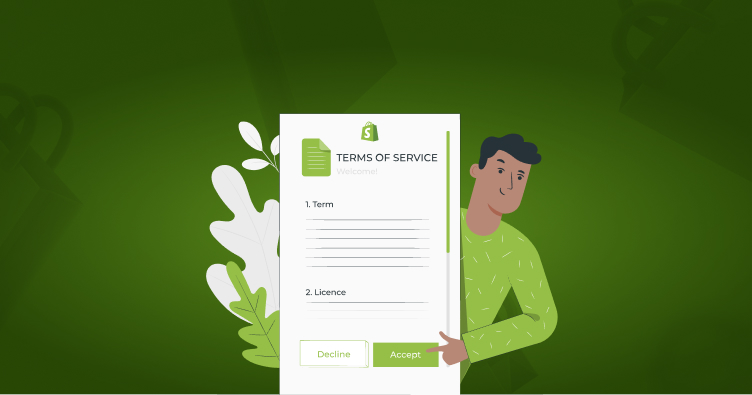How to Add Terms and Conditions on Shopify
Last Updated | January 16, 2024
Table of Contents
An overview: How to Add Terms and Conditions on Shopify
A solid Terms of Conditions agreement is just as crucial to any online business that sells products and services as picking a website layout. People are frequently perplexed by both the business and those documents, though, especially when they don’t get good Shopify development services.
As a result, we will explain what the terms and conditions are and why you need them in this article and give you instructions on how to add terms and conditions to the Shopify store.
We provide the best Shopify web design services, that would help you with How to Open a Shopify Store from the scratch. We have also got you covered How much does it cost to start a Shopify store in advance so you don’t have to do the work.
What Are The Terms and Conditions in Shopify?
The firm (you) that controls the site and mobile application and the users who can access your websites and mobile apps are bound by the terms and conditions pages as a legal contract. A Terms and Conditions agreement is not required by law, therefore having one is entirely up to you.
The restrictions that your consumers must abide by when shopping or visiting your website are actually all listed on the Terms and Conditions page. This is crucial because it safeguards you and demonstrates the absolute security and dependability of your websites. For example, Terms and Conditions will show whether or not your consumers breach your site’s Terms and Conditions. Customers won’t be able to hack your store or post offensive or derogatory comments. It is also required to discuss spam or other topics. Different names for the Terms and Conditions page, such as Terms of Use or Terms of Services, are possible.
To warn clients that they are not in your sites, which are vulnerable to Internet bad behavior like viruses or unfavorable remarks, is generally one of the major reasons you find Terms and Conditions vital for your site. If customers are attempting to argue with you, you can also point them to the Terms and Conditions.
Be aware that nearly all legitimate payment gateways will need you to include the Terms and Conditions on your website. So make sure that your Shopify integration solution services create and add while they work on your Shopify app development. Otherwise, you won’t be accepted.
Why Does Your Shopify Store Need Terms And Conditions?
It is now time for you to cover the three topics, which are the terms of service, privacy policy, and refund/return policy. Additionally, the majority of online retailers require one of them, thus as the store owner, it is crucial that you understand why you must have them on your websites. It is really necessary for the event that someone tries to sue you or if customers frequently have inquiries about the terms and conditions, policies, or any other site policy.
Your customers can find more information under the return policy. If customers have any issues with their purchases and want to send them back to you, it can specify what they really need to do. The policy is essential to your site’s ability to be transparent with its visitors. You are not always required to provide returns or refunds, but doing so is highly advised. Customers may see how long they have to return a product by doing this, and if your policy is transparent, reasonable, and succinct, they might be willing to buy from you.
How To Terms And Conditions To Your Shopify Store?
Basically, you can apply the HTML in your store policies’ content.
You could link the policies with the footer of the checkout pages once you’ve finished adding them. Even more intriguingly, you can include your policies in the menus for your online business.
Although it creates the templates, Shopify gives you control over your official policies. You simply need to check all your policies carefully before including them on your websites.
- Step #1 – Adding The Store Policies
Head to Settings > Legal
To begin, you need to head to Settings > Legal from the Shopify admin of your store.
- Step #2 – Adding Your Policies Or Selecting To Create From A Template
Next, you should create your own rules, or you can just select Create from the template to add the pre-existing rules. You should add styles and formatting to your policies using the text editors, as well as input photos and links.
- Step #3 – Revise your own policies and make any changes
In this step, Shopify merchants can review their own regulations once again and make any necessary modifications in this phase.
- Step #4 – Saving The Content Of The Terms And Conditions Page
Finally, to add your policies, click Save.
Your policies will automatically link to the footer of your checkout pages as you add them to your stores. Keep in mind that customers may need to view and review your policies before proceeding to the checkout page. It is therefore perfect for tying those pages together in the store navigation.
Conclusion about How to Add Terms and Conditions on Shopify
We hope that our post on how to add terms and conditions on Shopify store will help you understand the terms of your services better. Please get in touch with us if you want to hire someone to build the Shopify store, Folio3 is one of the leading Shopify Development Partners and helps Shopify merchants 24/7 with kinds of services related to Shopify, such as Shopify migration and more. Hire Shopify Developer and let your business grow.
FAQs About Terms and Conditions Shopify
What are the terms of service Shopify template?
When you create a Shopify account, you agree to our terms of service. This agreement sets out the terms and conditions that apply to your use of our platform, products, and services.
Our terms of service are designed to keep our community safe and secure, and to help us provide a consistent and enjoyable shopping experience for everyone. By using Shopify, you agree to these terms. If you do not agree to these terms, you may not use Shopify.
Our terms of service include:
– A code of conduct that outlines the expectations we have for all members of the Shopify community.
– A acceptable use policy that outlines the types of activities that are not permitted on our platform.
– A privacy policy that explains how we collect, use, and disclose personal information.
– A copyright policy that explains how we respond to claims of copyright infringement.
These terms are subject to change at any time, so we encourage you to check back periodically. If you have any questions about our terms of service, please contact us.
How to add terms and conditions checkbox shopify?
In order to add a terms and conditions checkbox to your Shopify store, you will need to add a snippet of code to your theme.liquid file. This can be done by going to Online Store > Themes > Edit code. Once you are in the theme.liquid file, you will need to locate the checkout form. This is typically near the bottom of the file. Once you have located the checkout form, you will need to add the following code:
{% if template.name == ‘checkout’ %}
<div class=”field”>
<input type=”checkbox” id=”terms” name=”terms” {% if checkout.terms_checked %} checked=”checked” {% endif %} />
<label for=”terms”>I have read and agree to the <a href=”/terms-and-conditions”>terms and conditions</a></label>
</div>
{% endif %}
This code will add a checkbox to the checkout page that customers will need to agree to before they can complete their purchase. If you have a link to your terms and conditions page, you can add it as well.












